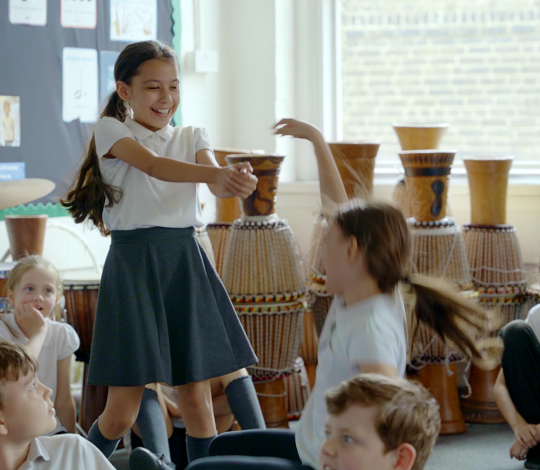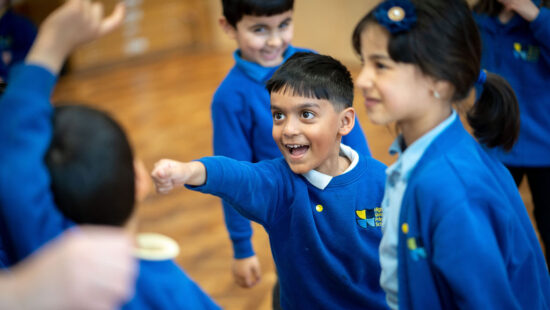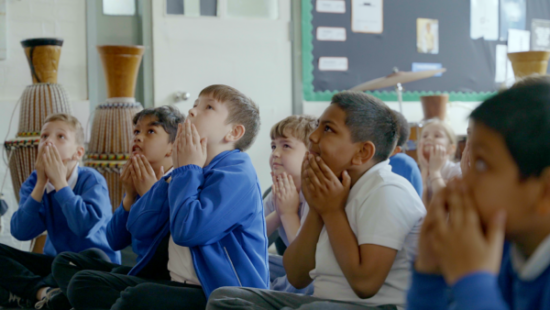Interdisciplinary learning in primary education: What & Why?

Interdisciplinary learning in primary education: What & Why?
In today’s primary classrooms, the pressure to meet curriculum targets can often lead to a fragmented school day, where subjects are taught in silos and creative time is squeezed in here and there.
But children don’t think or learn in closed sections.
That’s where interdisciplinary learning comes in, which is an approach that combines elements from different subject areas into one cohesive learning experience. It means children might explore a central theme, like identity, the environment, or community, through interweaving literacy, science, geography, music, drama and more.
At Artis, this is second nature. Our creative specialists use music, drama and movement to bring curriculum topics to life. A session exploring “growth,” for example, might cover plant life cycles (science), vocabulary building (literacy), rhythm (music), and sequencing (maths) all within one dynamic, creative lesson.
Why does it matter?
The benefits of an interdisciplinary, creative approach are clear:
- Deeper engagement – children are more motivated when they see the relevance of what they’re learning.
- Improved understanding – making connections between subjects helps embed knowledge.
- Stronger skills development – communication, collaboration, and critical thinking flourish in creative settings.
- Inclusivity – creative approaches give all children, regardless of ability or learning style, more ways to access and express their understanding.
- Better retention– by making lessons more memorable, it helps in retaining facts and knowledge
What does the research say?
-
Improves critical thinking and problem-solving
A 2021 study in the Journal of Educational Research found that interdisciplinary learning boosts young children’s ability to think critically and solve complex problems by encouraging connections across subjects rather than isolated facts. -
Enhances engagement and motivation
Research from Early Childhood Education Journal (2022) showed that younger students involved in interdisciplinary projects exhibit higher motivation and sustained engagement compared to traditional single-subject approaches. -
Supports social-emotional development
A 2023 review in Frontiers in Psychology reported that interdisciplinary learning, especially involving arts integration, promotes social-emotional skills like empathy, collaboration, and self-regulation in early years education.
Examples of interdisciplinary learning
- Singing about punctuation – Turn punctuation rules into songs or chants (e.g. a full stop rap, comma calypso).
- Rhythm and syllables – Use clapping games to teach syllable counting or build phonological awareness.
- Acting out fractions – Use physical objects or role-play (e.g. splitting pizza slices or groups of children) to explore halves, quarters, etc.
- Time travel shop – Children act out buying items using coins and giving change to practise money and time concepts.
- Dancing the solar system – Children use movement to orbit around a ‘sun’, modelling planetary motion.
- Heartbeat choreography – Explore the circulatory system by moving fast/slow to mimic pulse rates before and after exercise.
- Cave painting with charcoal – Create stone-age art and discuss early communication methods.
- Roman mosaics – Design tile patterns while learning about symmetry and ancient culture.
- Acting out Shakespeare – Simplify scenes for KS2 and act them out using expression and physicality.
- Hot-seating characters – Children answer questions in character from a class book or history topic.
- Emotion statues – Children create still shapes with their bodies to represent different feelings and discuss them.
- Walk the feeling – Explore empathy and perspective-taking by physically ‘walking’ as different characters.
- Weather soundscapes – Use instruments or body percussion to create rainstorms, thunder, or seasons.
- World music mapping – Link continents to music styles, instruments, or traditional dance.
Here are some simple ways to try it…
You don’t need to overhaul your planning to begin using interdisciplinary learning. Here are three simple ways to get started:
-
Link two subjects at a time – Start by pairing just two areas, like PE and science, or English and history. For example, explore muscles and movement through sports, or write diary entries from a historical figure’s perspective.
-
Use drama as a learning tool – Hot-seating, freeze-frames or miming vocabulary are easy, low-prep techniques that can be dropped into existing lessons.
-
Build in reflection time – At the end of the week, ask pupils to share links they noticed between subjects. This helps them make connections and reinforces learning.
Small, regular steps build confidence and impact over time.
Common concerns – and how to overcome them
Teachers often worry that interdisciplinary learning might take extra time or won’t meet curriculum demands. In reality, it can do the opposite.
-
Time-saving, not time-adding – One creative session can cover objectives from multiple subjects, freeing up timetable space elsewhere.
-
Curriculum-aligned – You’re not going off-piste – you’re deepening understanding within curriculum topics, not replacing them.
-
No extra resources needed – Start with what you have. Movement, storytelling, and role-play don’t require costly materials or training.
Interdisciplinary learning is a flexible approach that enhances – not complicates – teaching. It’s about making learning more joined-up, relevant, and memorable.
Bringing interdisciplinary learning earlier into the curriculum
Interdisciplinary learning doesn’t require a complete curriculum overhaul – it’s about finding natural ways for subjects to connect. In primary schools, where teachers already cover a broad range of subjects, there’s a clear opportunity to build in this approach early on. The key is to start with a shared theme, question or real-world issue that children can explore from different angles.
For example, a topic like “Our Local Area” could link geography (maps and local features), history (how the area has changed), English (writing reports or letters), and art (creating models or drawings).
One practical way to do this is to plan a termly topic together as a teaching team. Choose a theme relevant to your children’s lives or interests, and map out how each subject can contribute. You don’t need to force every subject to fit – just include the ones that make sense. Use class time to draw links explicitly, encouraging children to reflect on how what they’ve learned in one lesson connects to another.
Timetabling can remain flexible, but giving blocks of time to thematic projects, such as a “mini museum” week or a community-focused enquiry allows children to go deeper. Interdisciplinary learning helps children develop curiosity, problem-solving and collaboration skills, all while reinforcing core knowledge in a more meaningful way. Done simply and consistently, it can make learning more joined-up and engaging without adding extra workload.

